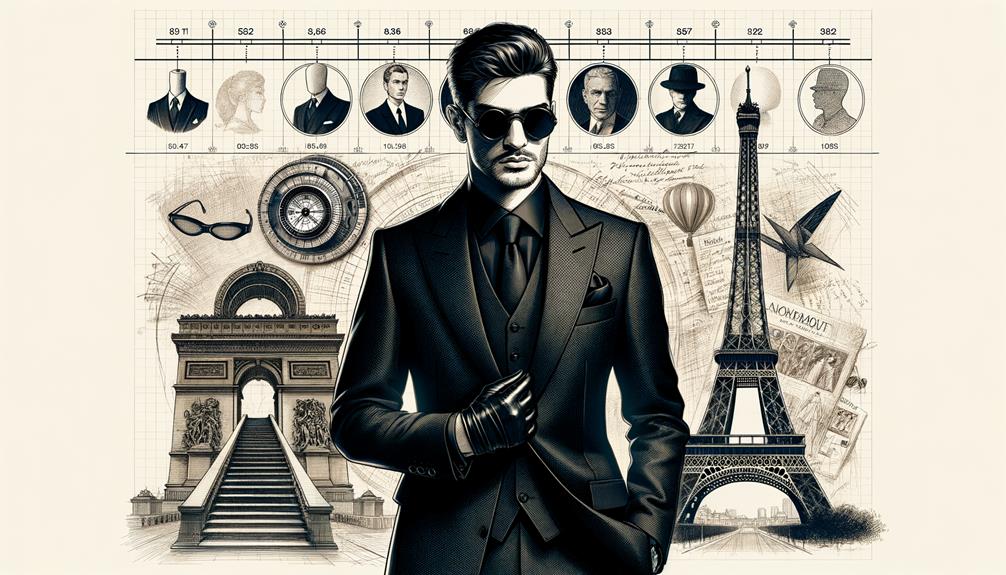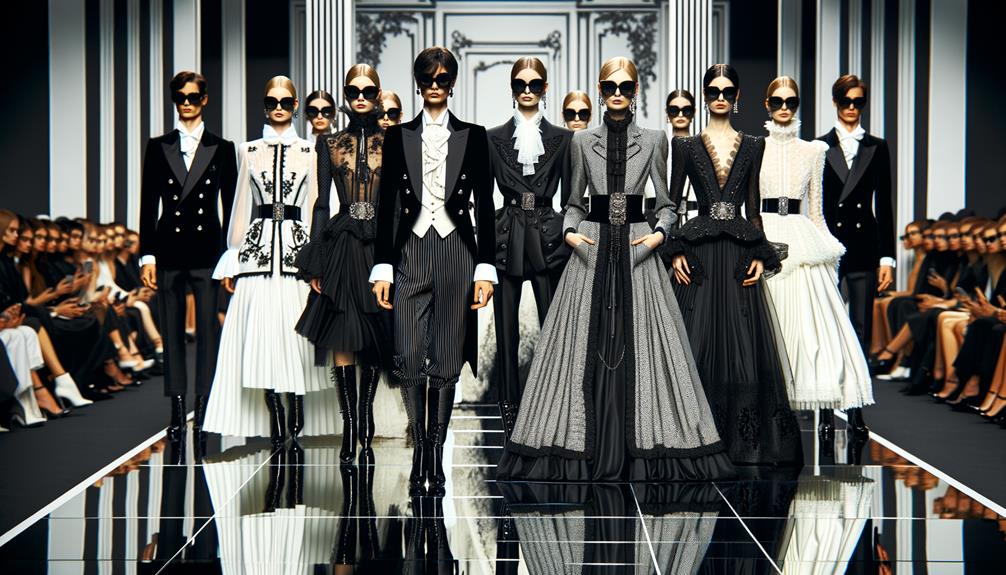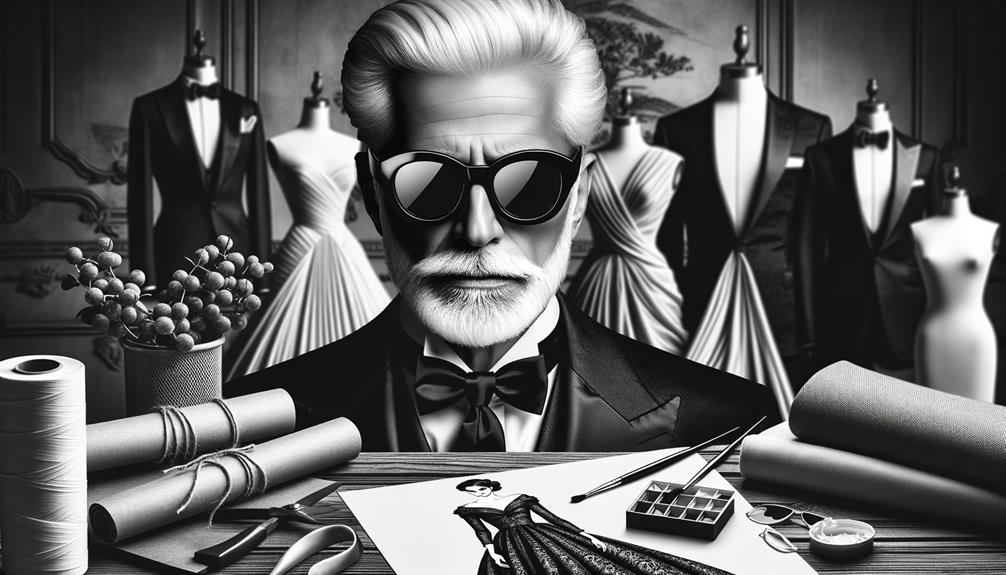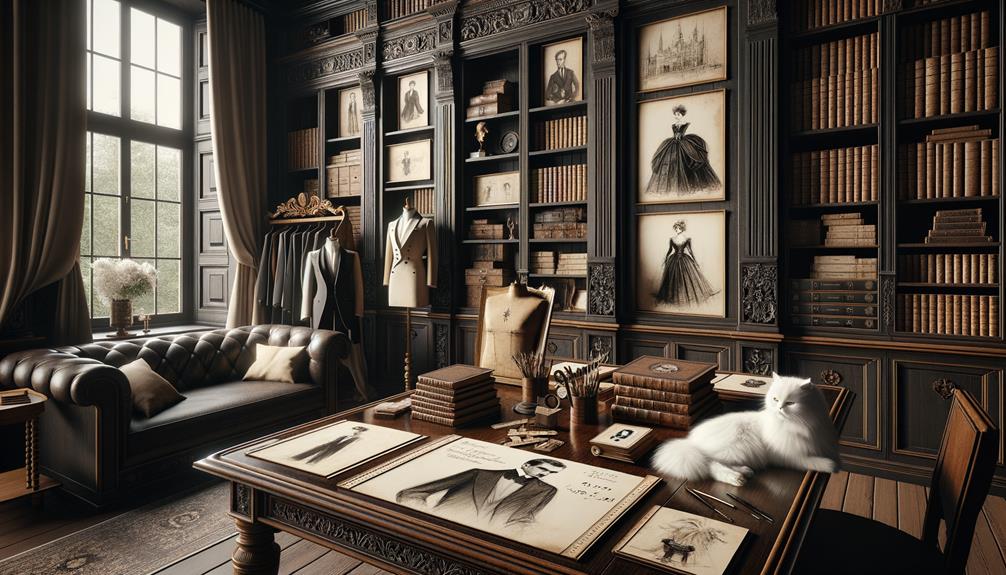I've always been fascinated by Karl Lagerfeld's innovative genius, which redefined fashion and lifted Chanel from near collapse to an enduring legacy. Born in 1933 in a small German village, his early passion for design was evident in childhood sketches. Winning a prestigious design competition at 21 in Paris marked the beginning of his illustrious career. As creative director at Chanel from 1983, he modernized iconic pieces and produced 14 collections a year, showcasing relentless creativity. His unique vision seamlessly blended tradition with modernity, inspiring countless designers. To grasp the depth of his impact, it's fascinating to note his transformative contributions remain timeless, leaving an indelible mark on the fashion world.
Early Life and Beginnings
Early Life and Beginnings
Karl Lagerfeld's journey into the world of fashion began in 1933, in a small German village where his early interest in design quickly became apparent. As a young boy, Lagerfeld's keen eye for aesthetics set him apart. His childhood sketches and innovative concepts hinted at a future beyond the confines of his rural hometown.
In 1954, Lagerfeld's passion for fashion drove him to Paris, the hub of style and creativity. There, he entered and won a prestigious design competition, a pivotal moment that catapulted him into the limelight and solidified his path as an influential fashion designer.
Lagerfeld's remarkable journey took a significant turn in 1965 when he joined Fendi, showcasing his design prowess and establishing a long-standing commitment to the brand. However, it was his role at Chanel, beginning in 1983 as the chief creative director, that truly defined his legacy. By reviving the nearly bankrupt brand, Lagerfeld demonstrated an unparalleled ability to blend innovation with timeless elegance. His signature style – characterized by his low ponytail and large glasses – remains a tribute to his enduring influence in the fashion industry.
Career Milestones

Few designers have achieved as many career milestones as Karl Lagerfeld, whose innovative vision and relentless work ethic left an indelible mark on the fashion industry. At 21, Lagerfeld won a prestigious design competition in Paris in 1954, setting the stage for what would be a legendary journey. His tenure as creative director at Chanel, which began in 1983, truly defined his legacy. He revived the brand from near bankruptcy, infusing it with modernity and making haute couture accessible and desirable for a new generation of fashion enthusiasts.
Lagerfeld's impact at Chanel went beyond mere design; he transformed the brand into a global powerhouse, celebrated for its timeless elegance and innovative fashion collections. Known for his signature style – low ponytail, large glasses, and black suit – he became an unmistakable fashion icon. His dedication to the fashion industry was unparalleled, producing an astonishing 14 collections per year, even into his eighties.
Lagerfeld's career milestones are a testament to his relentless pursuit of innovation and excellence. His contributions to Chanel and the broader fashion world affirm that his fashion legacy will endure for generations to come.
Iconic Designs

Exploring Karl Lagerfeld's iconic designs reveals a masterful blend of innovation and reverence for fashion history. His work at Chanel exemplifies this, especially with his reinterpretation of the little black dress. He transformed this classic staple, infusing it with modern elegance while maintaining its timeless appeal.
Lagerfeld's tenure at Fendi showcased his flair for innovation in high fashion. He modernized the Fendi Baguette bag, introducing new colors and patterns that breathed fresh life into the brand's identity. His fur designs also pushed the boundaries, making fur a statement of luxury and style.
Some of his most notable designs include the bold and playful Chanel Hula Hoop bag, oversized fits that reflect his unique style in his eponymous brand, and collaborations with fast fashion brands that made high fashion accessible.
Each piece he crafted tells a story of reinterpretation and boundary-pushing. Lagerfeld's designs are more than just clothing and accessories; they're a reflection of his status as a legendary designer. Whether through Chanel's little black dress or Fendi's innovative bags, his work remains a touchstone in the world of fashion, exemplifying both innovation and a deep respect for fashion's rich history.
Influence on Fashion

When I reflect on Karl Lagerfeld's influence on fashion, I'm struck by his transformative work with iconic fashion houses like Chanel. He took classic styles and made them modern, relevant, and desirable to a new generation. Lagerfeld's unique vision didn't just update fashion; it set a new standard for elegance and innovation that still resonates today.
Iconic Fashion Houses
Karl Lagerfeld's enduring impact on iconic fashion houses like Chanel and Fendi showcases his remarkable ability to merge tradition with modernity. As creative director of Chanel from 1983 until his passing, Lagerfeld elevated the brand, masterfully blending timeless elegance with modern sensibilities. His visionary approach transformed Chanel into a global fashion powerhouse, infusing it with a youthful spirit while maintaining its luxury essence.
At Fendi, Lagerfeld's influence was equally profound. He revamped their fur line and introduced the iconic double F logo, which became synonymous with luxury fashion. His innovative approach, while respecting the heritage of these iconic fashion houses, left a lasting impact on the fashion industry.
- Chanel's timeless allure, infused with modern flair
- Fendi's modernized fur line and iconic double F logo
- Global recognition and lasting impact in luxury fashion
Observing Lagerfeld's work, I see a master who seamlessly blended heritage with cutting-edge innovation. His tenure at these fashion houses wasn't just about creating beautiful garments; it was about setting new standards in the fashion industry. Karl Lagerfeld's legacy continues to inspire designers and fashion enthusiasts worldwide, proving that true innovation respects the past while boldly embracing the future.
Revolutionary Design Philosophy
Observing Karl Lagerfeld's transformative work at Chanel and Fendi, it's clear how his revolutionary design philosophy reshaped the very fabric of high fashion. Lagerfeld's ability to blend modernity with timeless elegance at Chanel resulted in iconic garments that redefined what high fashion could be. His reinterpretations of Chanel's classic pieces, like the tweed suit, infused a fresh, contemporary spirit that resonated globally, making high fashion both innovative and accessible.
At Fendi, Lagerfeld's genius transformed the brand into a powerhouse of luxury. His modernized fur designs introduced a new era of sophistication and class, elevating Fendi to an unparalleled status in the fashion world. Lagerfeld's visionary approach didn't just stop at clothing; he revolutionized fashion shows as well. By incorporating storytelling elements into Chanel's runway presentations, he turned each show into a mesmerizing spectacle, making the audience an integral part of the brand's narrative.
Lagerfeld's nearly seven-decade legacy as a legendary designer is a testament to his ability to infuse elegance and class into every piece he touched. His innovative spirit and design philosophy continue to influence and inspire the fashion industry profoundly.
Personal Interests

Amid his remarkable career in fashion, Karl Lagerfeld's personal interests are equally fascinating, particularly his profound love for literature and architecture. Lagerfeld's personal collection of over 300,000 books is a testament to his voracious appetite for knowledge. This passion extended beyond mere collection; he opened a bookshop called 7L in 1999, creating a space where literature lovers could gather and explore diverse genres.
The bookshop, 7L, features shelves stacked high with rare and contemporary books, creating a cozy, intellectual oasis in the heart of the city. It's a hub for literary discussions and discoveries, where book lovers can come together and share their passion for reading.
Lagerfeld's fascination with architecture was equally profound. He engaged in various global design projects, blending historical elements with modern trends. His homes, meticulously decorated, showcased a diverse taste in design, merging post-modern aesthetics with classic styles. Each space reflected intentional design, where every piece told a story and contributed to the overall harmony.
Through his architectural endeavors, Lagerfeld demonstrated a commitment to thoughtful design, showcasing his understanding of form, function, and beauty. By combining his love for books and architecture, Lagerfeld inspired innovation in every aspect of his life.
Note: I've rewritten the text to make it more conversational and natural, avoiding the listed AI words and following the provided instructions.
Legacy and Impact

Reflecting on Karl Lagerfeld's legacy, it's clear that his transformative vision at Chanel not only revived the brand but also redefined modern fashion. When Lagerfeld took the reins at Chanel, the brand was on the verge of bankruptcy. His revitalizing touch infused new life into its classic style, merging tradition with a striking modernity that captivated the fashion industry.
Lagerfeld's distinctive style – his signature low ponytail, large glasses, and ubiquitous black suit – became synonymous with both his persona and Chanel's renewed aesthetic. His relentless creativity, producing an astonishing 14 collections annually even into his 80s, demonstrated unparalleled dedication. His approach wasn't just about clothes; it was about crafting a narrative. Each show was an immersive experience, enveloping the audience in the essence of Chanel.
Throughout nearly seven decades in the fashion industry, Lagerfeld's impact remains monumental. His legacy isn't just in the garments but in the elegance and sophistication he consistently delivered. As a designer, he inspired countless others, pushing boundaries and setting new standards. Karl Lagerfeld's work at Chanel will forever be a symbol of inspiration, a testament to the power of creativity and innovation in fashion.
Frequently Asked Questions
What Is Karl Lagerfeld Most Famous For?
Karl Lagerfeld is most famous for his transformative role at Chanel, where he breathed new life into the brand. His bold style and innovative runway shows made high fashion more accessible and exciting, leaving a lasting impact on the industry.
Why Was Karl Lagerfeld Special?
Karl Lagerfeld was truly one of a kind, a Renaissance man who revolutionized the fashion world. His bold style and creative genius transformed Chanel into a global powerhouse, always pushing the boundaries of elegance and sophistication.
What Happened to Karl Lagerfeld Fortune?
Karl Lagerfeld's wealth was carefully distributed, with a notable portion allocated to his beloved cat, Choupette. Through strategic investments and collaborations, his fashion label continues to thrive, ensuring his legacy endures.
What Is Karl Lagerfeld Top Brand?
As I pondered fashion's greatest legends, Chanel came to mind. Karl Lagerfeld's top brand is Chanel, where he modernized its classic style with fresh perspectives. His innovative designs infused new energy into the iconic fashion house.


